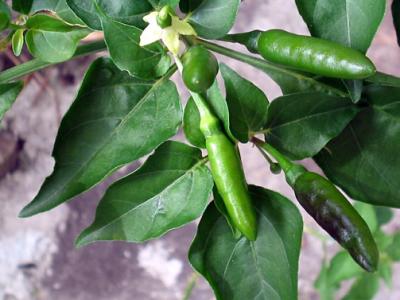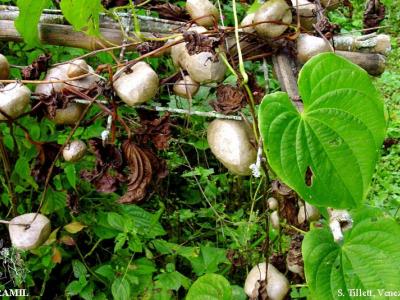(In territories with significant traditional TRAMIL use)
Dominican Republic:
- ají caribe
St Vincent and Grenadines:
- pepper bush
Haiti:
- piman caraïbe
- piman zwézo
leaf, heated and greased in fat, applied locally1-2
According to the information available:
The use for boils and lymph node inflammation is classified as REC based on the significant traditional use documented in the TRAMIL surveys and the toxicity studies.
Limit the application of the leaf to a maximum of three minutes after local erythema (redness) appears (normal reaction).
All topical application must follow strict hygiene measures in order to prevent contamination or additional infection.
For boils on the face or neck, self-medication is dangerous because of the risk of sepsis (generalised infection).
Due to the risks of documented interactions with drugs from the barbiturate group, people taking these drugs should avoid ingesting any part of the plant.
Not for use during pregnancy, breastfeeding or in children under 3 years.
The fruit of Capsicum annuum is a food of relatively widespread human consumption.
TRAMIL Work17
For boils or lymph node inflammation:
Wash the injury with boiled water and soap, apply 2-4 grams of heated leaf on the affected area.
note: the popular practice of smearing grease probably facilitates the extraction of the active ingredient with rubefacient effect, which is capsaicin, but it carries the risk of additional infection.
Preparations must never be stored for more than 24 hours, even if refrigerated.
1 GERMOSEN-ROBINEAU L, GERONIMO M, AMPARO C, 1984
Encuesta TRAMIL. enda-caribe, Santo Domingo, Rep. Dominicana.
2 WENIGER B, 1987-88
Encuesta TRAMIL. enda-caribe, Santo Domingo, Rep. Dominicana.
3 BALLAND V, GLASGOW A, SPRINGER F, GAYMES G, 2004
TRAMIL survey. enda-caribbean, IICA, UAG & U.PARIS XI, Saint Vincent.
4 GUTSU EV, KINTYA PK, LAZURIIEVSKII GV, Balashova nn, 1984
Steroid alkaloids and glycosides of Capsicum annuum L. Rast Resur 20(1):127-130.
5 POLITIS J, 1948
Distribution of chlorogenic acid in solanaceae and in the organs of these plants. Compt Rend 226:692-693.
6 TOMAS F, FERRERES F, 1980
Flavonoids from the leaves of Capsicum annuum (Solanaceae). I. Major components. Afinidad 37:517-518.
7 NOWACZYK L, 2011
Technlogical characteristics of fruit as an average of fruit as an average of soft-flesh Capsicum spp genotypes. Herba Polonica 57(2):38-44.
8 MARTINEZ MJ, BETANCOURT J, LOPEZ M, MOREJON Z, FUENTES V, MORON F, 2005
Antimicrobial effect of fresh leaves and their juice of Capsicum annuum. Informe TRAMIL. Laboratorio Central de Farmacología, Facultad de Ciencias Médicas “Dr. Salvador Allende”, La Habana, Cuba.
9 CICHEWICZ RH, THORPE PA, 1996
The antimicrobial properties of chili peppers (Capsicum species) and their uses in Mayan medicine. J Ethnopharmacol 52(2):61-70.
10 DUKE JA, 1992
Handbook of biologically active phytochemicals and their activities. Boca Ratón, USA: CRC Press.
11 DUKE JA, 2000
Chemicals and their biological activities in: Capsicum annuum L. Dr. Duke’s Phytochemical and Ethnobotanical Databases. USDA-ARS-NGRL, Beltsville Agricultural Research Center, Beltsville, USA, Aug.10,2000. URL: www.ars-grin.gov/cgi-bin/duke/farmacy2.pl
12 MARTINEZ MJ, BETANCOURT J, LOPEZ M, MOREJON Z, FUENTES V, MORON F, 2005
Irritabilidad dérmica primaria de hoja fresca en aceite de Capsicum annuum. Informe TRAMIL. Laboratorio Central de Farmacología, Facultad de Ciencias Médicas “Dr. Salvador Allende”, La Habana, Cuba.
13 MARTINEZ MJ, BETANCOURT J, LOPEZ M, MOREJON Z, FUENTES V, MORON F, 2005
Clases tóxicas agudas tópica de hoja fresca machacada de Capsicum annuum. Informe TRAMIL. Laboratorio Central de Farmacología, Facultad de Ciencias Médicas “Dr. Salvador Allende”, La Habana, Cuba.
14 DHAWAN BN, PATNAIK GK, RASTOGI RP, SINGH KK, TANDON JS, 1977
Screening of Indian plants for biological activity VI. Indian J Exp Biol 15(3):208-219.
15 GUZZO CA, LAZARUS GS, WERTH VP, 1996
Dermatological pharmacology. In: HARDMAN JG, GILMAN AG, LIMBIRD LE Eds. Goodman and Gilman’s the pharmacological basis of therapeutics. 9th ed. New York, USA: The McGraw-Hill Professional Publishing, International Edition.
16 PEISKER V, ARANGUREN ML, MONTERO DE ESPINOSA E, MORAES J, LEAL MS, SANZ J, 1995
Vademécum Internacional. Madrid, España: Medicom S.A.
17 CARBALLO A, 1995
Cálculo de concentración y dosis de las drogas vegetales TRAMIL: Mensuraciones farmacognósticas y aproximaciones técnico-clínicas. Laboratorio provincial de producción de medicamentos, Sancti Spiritus, Cuba.



